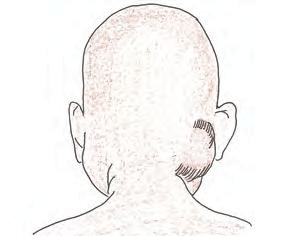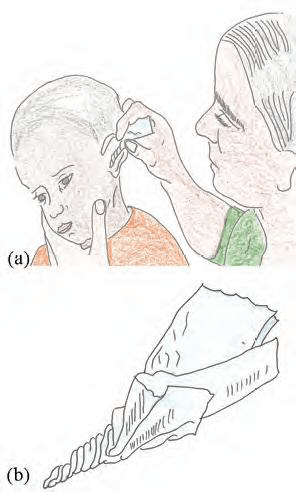Ear infections rarely cause death but are majority causes morbidity. In developing countries, they are the leading cause of deafness and learning problems. A child with an ear problem may have an ear infection which can cause ear pain and fever. If an ear infection is not treated on time, the eardrum will perforate, and the child will feel less pain. Examples of complications of untreated ear infections are meningitis, brain abscess, mastoiditis and deafness.
To assess and classify te ear problems caused by ear infection, you should ask about the ear problems to all the sick children. When you assess a child you will be looking for the following signs:
- Ear pain.
- Ear discharge, and if the discharge is present, how long the child has had the discharge.
- Tender is swelling behind the ear, a sign of mastoiditis.
Assess the child for an ear problem
Does the child have an ear problem?
IF YES, ASK:
Is there ear pain?.Is there ear discharge?.If yes, for how long?.
LOOK AND FEEL:
Look for pus draining from the ear.Feel for tender swelling behind the ear
ASK: Does the child have an ear problem?:
- If the mother answers no, you do not need to assess the child for ear problems.
- If the mother answers yes, ask the next question:
ASK: Does the child have ear pain?:
- If the mother is not sure that the child has ear pain, ask if the child has been irritable and rubbing his ear. Whether the answer is yes or no, you should ask the next question.
ASK: Is there ear discharge? If yes, for how long?:
- When asking about ear discharge, use words the mother understands.
- For example, "Is there any fluid that looks like pus coming out from the ears?" If the child has had ear discharge, ask the mother for how long.
LOOK for pus draining from the ear:
- Look inside the child‘s ear to see if pus is draining from the ear. Pus is usually white, creamy or light green and may have an offensive smell.
- An ear discharge that has been present for two weeks or more is defined as a chronic ear infection.
- An ear discharge that has been present for less than two weeks is defined as an acute ear infection.
FEEL for tender swelling behind the ear:
- Feel behind both ears. Compare them and decide if there is tender swelling of the mastoid bone. In infants, the swelling may be above the ear.
- Both tenderness and swelling must be present to classify mastoiditis, a deep infection in the mastoid bone (Figure 1, below).

Figure 1. Mastoiditis (tender swelling behind the right ear).
Classification of ear problems
Ear problems can be classified as:
- Mastoiditis.
- Acute ear infection.
- Chronic ear infection.
- No ear infection.
The table below shows the classification of ear problems. Mastoiditis requires urgent referral after giving paracetamol. And for an acute ear infection, it also requires immediate referral after giving one dose of Cotrimoxazole or Amoxicillin and paracetamol as needed.
Classification and treatment of ear problems
| Signs |
Classify |
Treatment |
Tender swelling behind the ear.
|
MASTODITIS |
Advise mother on the need for referral
Give Paracetamol for ear pain.
Advise mother to breastfeed more frequently if on BF
Refer to a health centre/hospital.
|
|
Pus is seen draining from the ear and discharge is reported for less than 14 days, or
Ear pain.
|
ACUTE EAR INFECTION |
Advise mother on the need for referral.
Give Paracetamol for ear pain.
1st dose of Cotrimoxazole/Amoxicillin.
Advise mother to breastfeed more frequently if on BF.Refer to a health centre/hospital.
|
|
Pus is seen draining from the ear and discharge is reported for 14 days or more
|
CHRONIC EAR INFECTION |
Keep ear dry by wicking
Advise mother to breastfeed more frequently
Follow up in 5 days
|
|
No ear pain and
No pus is seen draining from the ear.
|
NO EAR INFECTION |
No additional treatment.
|
Mastoiditis treatment
You must refer the child urgently to the hospital. The child needs treatment with appropriate antibiotics in a health centre or hospital. You should also treat his pain and high fever with paracetamol.
Acute ear infection treatment
You must refer the child urgently to hospital. Give the first dose of oral Cotrimoxazole or Amoxicillin to the child and relieve the ear pain and high fever with paracetamol.
Chronic ear infection treatment
If you see pus draining from the ear and discharge has been present for two weeks, or more, classify the child‘s illness as a chronic ear infection. Most bacteria that cause chronic ear infection are different from those which cause acute ear infections. The most important and effective treatment for chronic ear infection is to keep the ear dry by wicking. You should assess all children with a chronic ear infection for symptomatic HIV infection.
Dry a discharge from the ear (wicking)
To teach a mother how to dry the ear by wicking, first tell her it is important to keep an infected ear dry to allow it to heal. Then show her how to wick her child‘s ear.
As you wick the child's ear, tell the mother to:
- Use a clean, absorbent cotton cloth or soft, strong tissue paper for making a wick. She must not use cotton-tipped applicator, a stick or flimsy paper as these will fall apart in the ear
- Place the wick in the child‘s ear until the wick is wet.
- Replace the wet wick with a clean one.
- Repeat these steps until the wick stays dry. Then the ear is dry.
- Observe the mother as she practices (Figure 9.2, below) . Give feedback. When she is finished, give her the following information:
- Wick the ear three times daily.
- Use this treatment for as many days as it takes until the wick no longer gets wet when put in the ear and no pus drains from the ear.
- Do not place anything (oil, fluid, or other substance) in the ear between wicking treatments. Do not allow the child to go swimming. No water should get in the ear. Before the mother leaves, ask checking questions to ensure that she knows how to wick the child‘s ear at home.

Fig. 9.2. (a) Using an ear wick to treat an ear infection; (b) A wick should be made from clean cotton or strong tissue paper. Wick the ear three times daily.
No ear infection
- If there is no ear pain and no pus is seen draining from the ear, the child‘s illness is classified as no ear infection. The child needs no treatment.
Follow-up care:
- If you have classified a child with a chronic ear infection, you need to tell the mother to return for a follow-up visit five days after her first visit.
- Measure the child‘s temperature.
- Check that the mother is wicking the ear correctly. Encourage her to continue the ear wicking and discuss with her the importance of keeping the child‘s ear dry.
- Advice mother to breastfeed more frequently.


